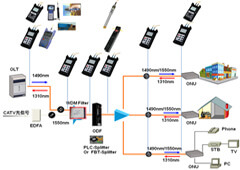All You Need to Understand About Robotic Vision and Its Applications in Advanced Optical Measurement Equipments
Robotic vision stands for a significant innovation in the intersection of computer system vision, artificial intelligence, and maker knowing. This technology enhances the precision of optical measurement systems, enabling real-time data analysis and improved high quality control. Its effect covers several industries, from producing to healthcare. The progressing landscape of robotic vision elevates questions regarding future capacities and applications. What developments exist in advance in this transformative area?
Understanding Robotic Vision: Secret Concepts and Technologies
Robotic vision incorporates the technologies and methods that enable machines to analyze and recognize visual information from their atmosphere. This area incorporates aspects of computer vision, fabricated knowledge, and artificial intelligence to promote computerized decision-making based on visual data. Secret ideas include photo handling, which entails the enhancement and evaluation of images to draw out purposeful functions, and object acknowledgment, which allows devices to recognize and identify items within a scene.

The Combination of Robotic Vision With Optical Measurement Systems
As industries increasingly demand precision and performance, the integration of robotic vision with optical dimension systems has actually emerged as a transformative approach. This harmony allows robots to view and analyze their surroundings, enhancing the capability of optical dimension systems to evaluate and examine things with unmatched precision. By furnishing optical sensors with sophisticated imaging innovations, robot vision allows real-time information collection and processing, assisting in instant adjustments to measurement parameters.
Furthermore, the combination equips automated systems to find variants in measurements, surface area top quality, and positioning, which are crucial in quality control procedures. Boosted algorithms, such as artificial intelligence, further enhance this assimilation by improving the systems' capacity to adjust to different settings and scenarios. The integration not just simplifies dimension processes but likewise minimizes errors, making certain that items satisfy stringent sector criteria, consequently solidifying the duty of robot vision in the future of optical measurement systems.
Applications of Robotic Vision in Production
In modern production atmospheres, making use of vision systems has actually changed production procedures by making it possible for devices to do jobs with impressive precision and speed. Robotic vision systems are progressively used for high quality control, where they examine items for defects and assurance adherence to specs. These systems make use of cams and advanced algorithms to examine products in real-time, significantly decreasing the risk of human error.
Additionally, robot vision promotes automation in production line, enabling robots to properly determine elements and assemble them with marginal downtime. This modern technology likewise enhances inventory monitoring, as vision systems can check stock levels and identify disparities, assuring a smooth supply chain.
Furthermore, robot vision help in the execution of smart factories, where information from vision systems check my reference can be integrated with other modern technologies to maximize operations. Overall, the applications of robot vision in producing demonstrate its essential function in boosting effectiveness, quality, and performance throughout numerous fields
Robotic Vision in Healthcare: Reinventing Patient Care

In recovery, robot vision aids in checking patient progress and customizing treatment sessions to specific needs. It supports clinical professionals by automating tasks such as information collection and client tracking, permitting more time to concentrate on direct individual interaction. Furthermore, robotic vision improves telemedicine by allowing remote diagnosis and digital appointments, connecting the gap between people and medical care providers. On the whole, the application of robotic vision in healthcare is revolutionizing patient treatment, resulting in improved results, efficiency, and person fulfillment.
Future Fads and Developments in Robotic Vision Innovation
The fast advancement of robotic vision modern technology guarantees to further boost its applications across numerous fields, including medical care. Future patterns show a considerable change towards including expert system and artificial intelligence, making it possible for systems to gain from large datasets and improve precision with time. Boosted sensing unit technologies and deep learning formulas are anticipated to improve item recognition capabilities, permitting robots to interpret complicated settings much more effectively.

The integration of augmented truth (AR) with robotic vision will likely transform exactly how robotics help in medical procedures and diagnostics. This synergy will assist in real-time information visualization, boosting decision-making procedures. Additionally, miniaturization of elements will cause more compact and functional robotic vision systems ideal for a selection of jobs. As these developments unfold, industries will certainly witness increased automation and effectiveness, solidifying my website robotic vision as a cornerstone of innovative technological solutions.
Regularly Asked Inquiries
What Are the Key Parts of a Robotic Vision System?
The primary components of a robotic vision system include video cameras for photo capture, processors for information analysis, algorithms for analysis, and actuators for motion. With each other, these aspects allow robots to perceive and connect with their setting properly.
Just How Does Robotic Vision Improve Precision in Measurements?
Robotic vision enhances dimension precision by utilizing innovative imaging technologies, allowing accurate things discovery and spatial evaluation. This capability decreases human mistake, raises repeatability, and enables for real-time modifications, eventually boosting general dimension integrity and performance.
What Industries Advantage Many From Robotic Vision Technology?
Numerous industries benefit significantly from robot vision technology, including production, medical care, agriculture, and logistics. These sectors use improved accuracy, effectiveness, and automation, causing boosted efficiency and lowered operational prices in their particular procedures.
Can Robotic Vision Equipments Operate In Low-Light Conditions?
Robotic vision systems can indeed work in low-light problems, making use of innovative sensors and algorithms to enhance picture quality. This capability allows them to carry out successfully in numerous environments, consisting of industrial and monitoring applications, despite very little lighting.
What Are the Expenses Linked With Executing Robotic Vision?
The expenses associated with applying robot vision differ substantially, influenced by parts such as electronic cameras, software program, and combination. Added expenditures consist of upkeep, training employees, and potential upgrades Get the facts to existing systems, which can accumulate gradually.